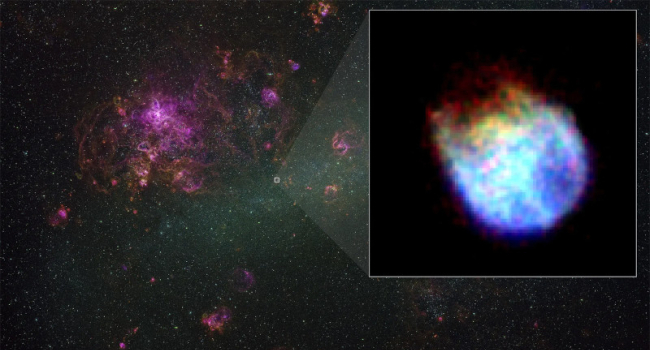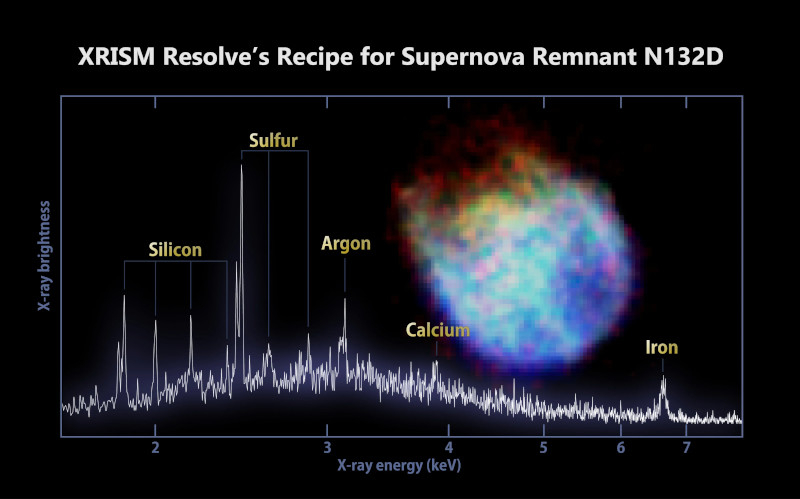
NASA and JAXA release detailed image of supernova explosion in neighboring galaxy
The American NASA together with the Japan Aerospace Exploration Agency (JAXA) has shown a detailed X-ray image of the explosion of a star in the depths of space. This research breakthrough was made possible by the XRISM (X-ray Imaging and Spectroscopy Mission) space telescope, which aims to study the hottest regions of the universe. This is the first scientific XRISM image, and with it, scientists have for the first time carried out a detailed analysis of the supernova remnant known as N132D.
Analysis of the XRISM data is of particular interest, as it allowed researchers to determine the elemental composition of the supernova remnant. These elements formed inside the star and were ejected when it exploded.
"The Resolve tool allows us to see the shape of spectral lines with unprecedented precision, which will allow us to determine not only the composition of various elements, but also their temperature, density and direction of their movement. From here we can gather information about the primordial star and its explosion," said Brian Williams, NASA's XRISM project scientist, speaking about the importance of this discovery.
The XRISM X-ray telescope was launched in September last year and was still in the tuning phase until recently, and now it has sent back its first image. The low-orbiting telescope will help study the universe in the high-energy X-ray range. The device will help to study the largest structures in the universe, to determine the mechanisms of distribution of matter and the formation of galaxies with supermassive black holes in their centers. This will allow a better understanding of the mechanisms of the formation and evolution of the universe.

Resolve is a high-precision soft X-ray (longest wavelength) spectrometer that operates at temperatures just a few hundredths of a degree above absolute zero and is capable of capturing X-ray spectra at energies from 300 to 12,000 electron volts. It measures the tiny changes in temperature that occur when an X-ray beam hits its 6x6 pixel detector. The spectra it produces are the most detailed ever obtained for objects in space.
The Resolve device works with limitations because scientists were unable to open a protective window on one of the sensors, which affects sensitivity. This layer is designed to protect the sensor from exposure to Earth's atmosphere and after launch, as it prevents gaseous materials inside the satellite from sticking to the optical filters. The window section has a 250 micron thick beryllium film, thanks to which the device can work with X-rays even when the section is closed. The beryllium window shields X-rays below 2,000 volts, while without the shielding window X-rays could be tracked at energies up to 300 volts.
Xtend is an X-ray soft-field camera designed to extend the telescope's field of view to 38 arcminutes per side in the energy range of 400–13,000 electron volts. This large field of view allows viewing of areas about 60% larger than the average apparent size of the full moon, making it a powerful tool for obtaining detailed X-ray images of celestial objects such as galaxy clusters and supernova remnants.
The results obtained with XRISM play a significant role in understanding cosmic processes. A discovery of this scale is an important step in expanding the boundaries of our knowledge of the Universe and studying the processes of formation of the elements that form the basis of the universe.
- Related News
- Wheel of Death: new method will help astronauts stay fit in low gravity
- Due to anomalies of Orion spacecraft, lunar exploration program may be delayed for years։ NASA
- TAO Observatory: World's highest telescope to study evolution of galaxies and exoplanets
- Powerful M9.5 solar flare causes radio blackout in Pacific Ocean
- What will happen to the Earth if the Moon disappears?
- Key to conquering the Red Planet: Why is NASA studying solar storms on Mars?
- Most read
month
week
day
- Digital Julfa Network is launching a pan-Armenian centre in the metaverse, on the Fastexverse virtual platform 928
- Xiaomi unveils exclusive Redmi Note 13 Pro+ dedicated to Messi and Argentina national team 815
- Sparkles: Boston Dynamics unveils a furry robot dog that can dance (video) 802
- Is there a ninth planet in the solar system? Scientists find new evidence 679
- Smartphone catches fire in child's hand in Russia 658
- What will happen to the Earth if the Moon disappears? 656
- How to understand how protected a smartphone is from water and dust? 639
- World's largest 3D printer was created in USL It prints 29 meter-long structures 623
- iPhone 16 may get colored matte glass back panel, 7 colors 623
- New iPad Pro to receive M4 chip and to be more powerful than Apple computers 613
- Archive
